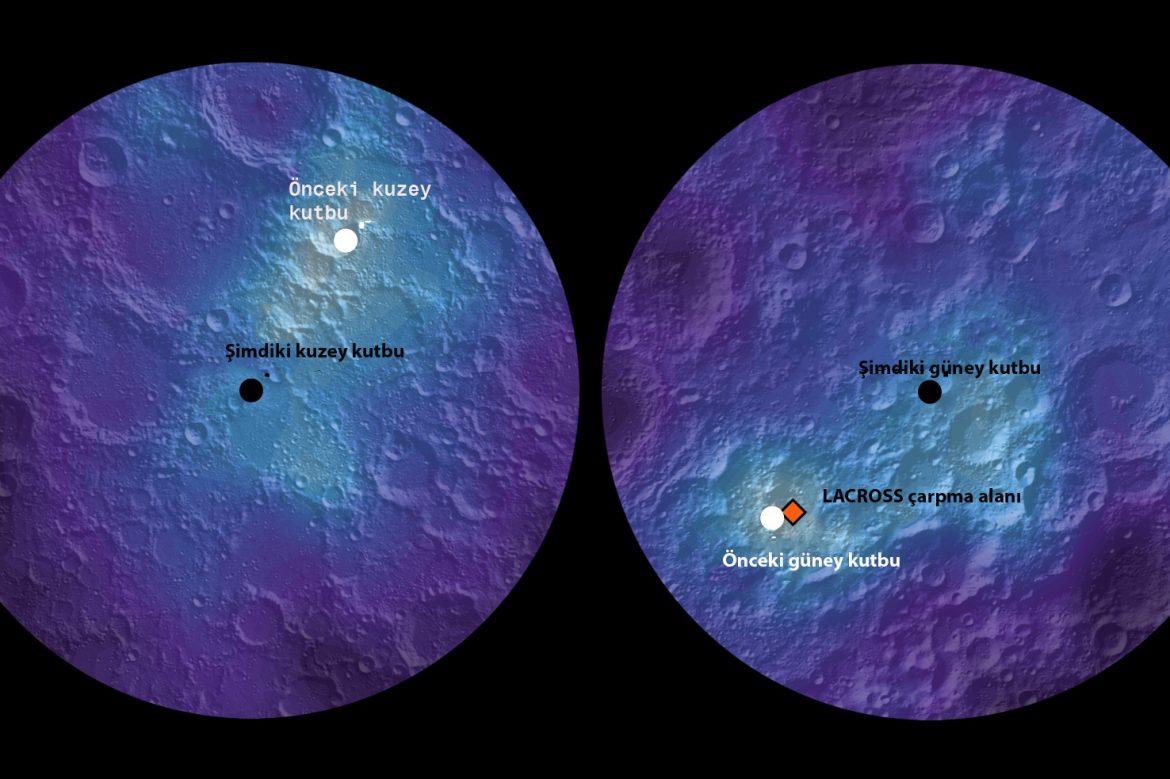Poles wandered as axis shifted…
A study based on the traces of ice on lunar surface has shown that the natural satellite of the Earth had undergone a shift of axis three billion years ago. When the Moon’s north and south poles wandered slightly as a result of that shift, “the man in the moon” ilfted his nose up at us.
According to the findings of the study led by Matthew Siegler of the Southern Methodist University at Dallas and Institute of Planetary Sciences, at Tucson, Arizona and published in the 23 March issue of Nature, a change in the distribtion of mass in the lunar crust as a result of geological activities caused the Moon’s polar axis to shift 5-6 degrees relative to its direction when it first formed.
Going through the data gathered by tye spacecraft NASA had put in orbit around the Moon, the team discovered that the densest collections of ices on lunar surface were located some distance from the poles.
Among these craft were the Lunar Prospector which was smashed into a crater near the Moon’s southern pole at the end of mission in 1999 and the LCROSS, which first crashed the upper stage of the rocket it was riding on to the surface near the south pole and, analysing the debris it kicked up, relayed the data to the Earth before it took a suicide dive itself. Thanks to data provided by these spacecraft, the presence of ice in permanently shaded parrts of the lunar surface was firmly established.
What the water says
In the absence of an atmosphere, and hence, of pressure, the ice sublimates into space when it is exposed to sunlight. NASA spacecraft determined the presence of ice left on the surface with sensitive neutron detectors and spectrometers they carry. Of the neutrons kicked up into spce by cosmic rays raining on the Moon, those with lower energies provide evidence for the presence of hydrogen in water molecules (or ice crystals). The hydrogen nuclei in an ordinary water molecule are single protons, and are not accompanied by neutrons. But in deuterium, a heavier version of hydrogen, the nucleus contains a neutron alongside the proton. The water molecule made up of two deuterium atoms instead of hydrogen beside the single oxygen atom is called “heavy water.” It’s these heavy hydrogen isotopes which is the sources of neutrons detected by orbiters as evidence of water on lunar surface. It is known that ratio of deuterium in water molecules closer to the nascent Sun during the formation of the Solar System is lower compared to those forming in the outer reaches of the solar nebula. Previous studies based on this phenomenon concluded that the water on Earth – and on the Moon which formed from the debris kicked up when a Mars-sized planetsimal collided with the Earth soon after its formation – was ferried by meteorites which came from the asteroid belt between Mars and Jupiter and impacted our planet.
Analysing the data from the orbiters, the researchers found that largest concentrations of ice in both polar regions were offset in opposite directions and equal distances from the poles.
This shows that the poles had wandered some 200 km in opposite directions. According to Siegler, considering the difference in sizes, this polar wander on the moon cporresponds to Earth’s southern pole shifting from its current position in Antarctica to Australia – 8500 kilometers away!
A bubble of molten rock!
According to researchers, the polar wander began about three billion years ago and it took a billion years for the poles to come to their present positions. Polar wander is not a common phenomenon for the Solar System, they note, besides the Moon seen only at Earth, Mars, Saturn’s moon Enceladus and Jupiter moon Europa. The shift of Earth’s polar axis is attributed to tectonic dynamics of its broken crust, whereas that of Mars is explained with asymmmetric distribution of mass due to a dense and heavy volcanic region. As for the Moon’s polar wander, researchers link it to dynamics deep inside. In the process of the Moon’s formation (from the debriskicked into Earth orbit by the impacting planetsimal, heavy radioactive materials collected at a region of the crust. The heat produced through their decay caused a part of the mantle underneath to melt and slowly rise to the surface like a bubble in a lava lamp. Being lighter than the denser mantle around, this giant magma bubble rose to the surface filling low-lying dark areas which form the face of the “man in the Moon” with lava. And the resulting imbalance in the distribution of mass in the mantle caused the whole lunar surface to move upward and “lift its nose!”
REFERENCES
- 1. “NASA data leads to rare discovery: Earth's moon wandered off axis billions of years ago”, Southern Methodist University, 23 March 2016
- 2. “Ancient Polar Ice Reveals Tilting of Earth’s Moon”, ScienceOnline, 23 March 2016
- 3. http://www.smithsonianmag.com/science-nature/the-water-on-the-moon-probably-came-from-earth-56638271/?no-ist

